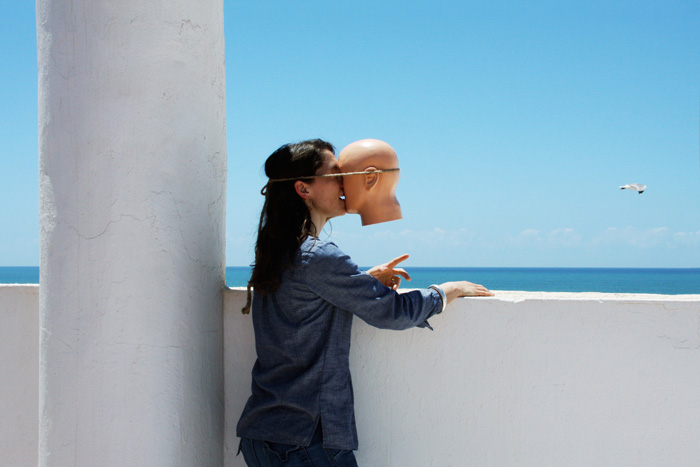patrick
Shared posts
Cybele Young’s Paper Sculptures Depict Everyday Objects Metamorphosing into Otherworldly Creatures

I Thought They Worked Better. Paper. 33 x 28 x 2.5 in.

I Thought They Worked Better. Detail.
A pair of yellow headphones. A violin case. A set of keys. All miniature objects faithfully crafted from Japanese papers by Toronto-based artist Cybele Young, any one of which would be considered striking in its own right, but she doesn’t stop there. Each object, however mundane, is displayed step-by-step in a dramatic process of metamorphosis as it transforms into unusual organic lifeforms. A pair of rollerskates gradually becomes a network of fungus-like membranes, or an ordinary handbag grows an unnerving coat of sharp spikes. From her artist statement:
Engaging with abstract and familiar motifs, I juxtapose sculptures to create a sense of dialogue or play between them. I approach my work in series and components, ultimately building an ongoing inventory of personal experience and observation.
I compile these in various arrangements to create communities that interact and form new relationships – much like the small seemingly insignificant moments in our everyday lives that come together to create unexpected outcomes. These manifest as miniature theatres – one act plays, where shifts of scale and perception occur. Despite the absence of the human form there is an implied presence, where the viewer can project themselves into another world.
Young’s work is currently on view for two more days at Forum Gallery in New York, so don’t miss it. (via Colossal Submissions, thnx David!)


You Know That Place. Paper. 30 x 40 x 4 in.

If I Had Learned Earlier. Paper. 22 x 35 x 2.5 in.

In Close Range. Paper. 24 x 35 x 2.5 in.

It Came With Me Everywhere. Paper. 19 x 38 x 4 in.

It’s Worth it This Time. Paper hair curler, coils. 21 x 32 x 2 in.

It’s Worth it This Time. Detail.

I Was Thinking of Something Else. Paper lawn chair, leaves. 17 x 24 x 3 in.
 I Was Thinking of Something Else. Detail.
I Was Thinking of Something Else. Detail.
The Fourth Wall: A Rare View of Famous European Theater Auditoriums Photographed from the Stage
patrickwow !

For his ongoing series The Fourth Wall, Hamburg-based photographer Klaus Frahm shatters the illusion of stagecraft by taking us behind-the-scenes of several European theaters. Shot from the vantage point of the stage looking toward the audience, the photos reveal the stark contrast of ornate auditoriums and the technological scaffolding that facilitates a major theatrical production. Frahm captures the elaborate configurations of lights and the surprising enormity of the fly space hidden just behind the red curtain that can be up to three times larger than the seating area.
Frahm says the intention behind his photography “is to give way for a new perspective, to entertain, to offer a fresh sight on familiar things,” and to “reveal something laying under the surface.” The Fourth Wall project began in 2010 when he was documenting a new theater for an architect which involved a series of shots facing the wings and other angles from the stage. When reviewing his polaroids later that day he was immediately struck by the image-within-an-image contrast of the warm, fully-lit theater seats and the cold, hidden infrastructure. Klaus had ingeniously turned the tables: suddenly the audience was the spectacle and the stage was reality.
You can see more from the Fourth Wall series on Fram’s website. If you enjoyed this, also check out the work of David Leventi. (via It’s Nice That, thnx Kevin!)







MoMA | The Collection | Gilbert Lesser. Equus. 1974
I had a dream, which was not all a dream
Title: Lord Byron








Atley
The Meticulous 10-Month Restoration of a 355-Year-Old Painting at the Metropolitan Museum of Art
Completed in 1660, Charles Le Brun’s painting of Everhard Jabach and His Family had seen better days. The 355-year-old family portrait was covered in a badly tinted varnish, had multiple superficial scratches and structural damage had split the painting nearly in half. This video documents the 10-month restoration at the Metropolitan Museum of Art lead by Michael Gallagher that involved retouching, structural work, re-varnishing, and numerous other conservation techniques to bring this giant painting back to life. The Met also documented the process in some 20+ blog posts over on their website. (via Sploid)






Free Ride: A Crow Catches a Lift on the Back of a Bald Eagle

Photographer Phoo Chan has seen more than his fair share of spectacular moments while photographing birds and other wildlife around his home in California, but perhaps nothing will ever top what he witnessed last spring while shooting near Kitsap, Washington: a crow riding atop a bald eagle. It only lasted for a few seconds, but Chan managed to capture the entire encounter on film. He shares about the image:
Crows are known for aggressively harassing other raptors that are much bigger in size when spotted in their territories and usually these ‘intruders’ simply retreat without much fuss. However, in this frame the crow did not seem to harass the bald eagle at such close proximity and neither did the bald eagle seem to mind the crow’s presence invading its personal space. What made it even more bizarre was that the crow even made a brief stop on the back of the eagle as if it was taking a free scenic ride and the eagle simply obliged.
You can see more of Chan’s bird photography on 500px and Flickr. (via Bored Panda, @pourmecoffee, Stellar)




Photos of Buildings Up-Close
Roland Fischer’s up-close photos of buildings around the globe are making my graphic designer heart sing!
(via CreativeMornings)
Kinetic Hair Dryer Installations by Antoine Terrieux

As part of an exhibition last December at the Maison Des Jonglages (House of Juggling) in La Courneuve, France, magician and juggler Antoine Terrieux created this series of kinetic artworks using different arrangements of hair dryers. The dryers were positioned in such a way as to create an updraft for a paper airplane to fly around, a spinning vortex of water vapor, and other unexpected configurations. Terrieux also incorporates hair dryers into his performances. (via La boite verte)
Bach in Lights: The Well-Tempered Clavier Graphically Visualized Through a Twisting Gallery of Light Bulbs
This exceedingly clever animation by artist Alan Warburton transforms two compositions from J.S. Bach’s The Well Tempered Clavier (Prelude and Fugue in C Major) into a visual interpretation of music. Warburton used a form of graphical notation manifested as thousands of fluorescent light bulbs mounted around a gallery space and parking garage. As each light pops on in sync with the music, the bulb shape correlates with with length and pitch of each note.
You can learn more about how Warburton and a team of programmers and sound designers created the piece over on Sinfini Music who commissioned the piece. Music performed by Pierre-Laurent Aimard.

Bruce Shapiro’s Mesmerizing Kinetic Sand Drawing Machines
patrickWOW
In a 21st century take on the traditional Zen sand garden, artist Bruce Shapiro invented the Sisyphus Machine, an elaborate kinetic drawing machine that uses magnets to drag rolling steel marbles through a thin layer of sand to create complicated mandala-like patterns. Shapiro, who was once a practicing physician, has spent the better part of 25 years experimenting with computerized motion control and many of his Sisyphus Machines have been installed in locations around the world including a large device in Switzerland back in 2003 and at Questacon in Canberra, Australia in 2013. It appears the artist is currently working on a tabletop consumer version and if you’re interested you can sign up for his mailing list here. (via Core77, Fast Company)






Greek Gods, Moles, and Robot Oceans
 [Image: The Very Low Frequency antenna field at Cutler, Maine, a facility for communicating with at-sea submarine crews].
[Image: The Very Low Frequency antenna field at Cutler, Maine, a facility for communicating with at-sea submarine crews].There have been about a million stories over the past few weeks that I've been dying to write about, but I'll just have to clear through a bunch here in one go.
1) First up is a fascinating request for proposals from the Defense Advanced Research Projects Agency, or DARPA, who is looking to build a "Positioning System for Deep Ocean Navigation." It has the handy acronym of POSYDON.
POSYDON will be "an undersea system that provides omnipresent, robust positioning" in the deep ocean either for crewed submarines or for autonomous seacraft. "DARPA envisions that the POSYDON program will distribute a small number of acoustic sources, analogous to GPS satellites, around an ocean basin," but I imagine there is some room for creative maneuvering there.
The idea of an acoustic deep-sea positioning system that operates similar to GPS is pretty interesting to imagine, especially considering the strange transformations sound undergoes as it is transmitted through water. To establish accurately that a U.S. submarine has, in fact, heard an acoustic beacon and that its apparent distance from that point is not being distorted by intervening water temperature, ocean currents, or even the large-scale presence of marine life is obviously quite an extraordinary challenge.
As DARPA points out, without such a system in place, "undersea vehicles must regularly surface to receive GPS signals and fix their position, and this presents a risk of detection." The ultimate goal, then, would be to launch ultra-longterm undersea missions, even establish permanently submerged robotic networks that have no need to breach the ocean's surface. Cthulhoid, they will forever roam the deep.
 [Image: An unmanned underwater vehicle; U.S. Navy photo by S. L. Standifird].
[Image: An unmanned underwater vehicle; U.S. Navy photo by S. L. Standifird].If you think you've got what it takes, click over to DARPA and sign up.
2) A while back, I downloaded a free academic copy of a fascinating book called Space-Time Reference Systems by Michael Soffel and Ralf Langhans.
Their book "presents an introduction to the problem of astronomical–geodetical space–time reference systems," or radically offworld navigation reference points for when a craft is, in effect, well beyond any known or recognizable landmarks in space. Think of it as a kind of new longitude problem.
The book is filled with atomic clocks, quasars potentially repurposed as deep-space orientation beacons, the long-term shifting of "astronomical reference frames," and page after page of complex math I make no claim to understand.
However, I mention this here because the POSYDON program is almost the becoming-cosmic of the ocean: that is, the depths of the sea reimagined as a vast and undifferentiated space within which mostly robotic craft will have to orient themselves on long missions. For a robotic submarine, the ocean is its universe.
3) The POSYDON program is just one part of a much larger militarization of the deep seas. Consider the fact that the U.S. Office of Naval Research is hoping to construct permanent "hubs" on the seafloor for recharging robot submarines.
These "hubs" would be "unmanned, underwater pods where robots can recharge undetected—and securely upload the intelligence they’ve gathered to Navy networks." Hubs will be places where "unmanned underwater vehicles (UUVs) can dock, recharge, upload data and download new orders, and then be on their way."
"You could keep this continuous swarm of UUVs [Unmanned Underwater Vehicles] wherever you wanted to put them... basically indefinitely, as long as you’re rotating (some) out periodically for mechanical issues," a Naval war theorist explained to Breaking Defense.
The ultimate vision is a kind of planet-spanning robot constellation: "The era of lone-wolf submarines is giving away [sic] to underwater networks of manned subs, UUVs combined with seafloor infrastructure such as hidden missile launchers—all connected to each other and to the rest of the force on the surface of the water, in the air, in space, and on land." This would include, for example, the "upward falling payloads" program described on BLDGBLOG a few years back.
Even better, from a military communications perspective, these hubs would also act as underwater relay points for broadcasting information through the water—or what we might call the ocean as telecommunications medium—something that currently relies on ultra-low frequency radio.
There is much more detail on this over at Breaking Defense.
4) Last summer, my wife and I took a quick trip up to Maine where we decided to follow a slight detour after hiking Mount Katahdin to drive by the huge antenna field at Cutler, a Naval communications station found way out on a tiny peninsula nearly on the border with Canada.
We talked to the security guard for a while about life out there on this little peninsula, but we were unable to get a tour of the actual facility, sadly. He mostly joked that the locals have a lot of conspiracy theories about what the towers are actually up to, including their potential health effects—which isn't entirely surprising, to be honest, considering the massive amounts of energy used there and the frankly otherworldly profile these antennas have on the horizon—but you can find a lot of information about the facility online.
 So what does this thing do? "The Navy's very-low-frequency (VLF) station at Cutler, Maine, provides communication to the United States strategic submarine forces," a January 1998 white paper called "Technical Report 1761" explains. It is basically an east coast version of the so-called Project Sanguine, a U.S. Navy program from the 1980s that "would have involved 41 percent of Wisconsin," turning the Cheese State into a giant military antenna.
So what does this thing do? "The Navy's very-low-frequency (VLF) station at Cutler, Maine, provides communication to the United States strategic submarine forces," a January 1998 white paper called "Technical Report 1761" explains. It is basically an east coast version of the so-called Project Sanguine, a U.S. Navy program from the 1980s that "would have involved 41 percent of Wisconsin," turning the Cheese State into a giant military antenna.Cutler's role in communicating with submarines may or may not have come to an end, making it more of a research facility today, but the idea that, even if this came to an end with the Cold War, isolated radio technicians on a foggy peninsula in Maine were up there broadcasting silent messages into the ocean that were meant to be heard only by U.S. submarine crews pinging around in the deepest canyons of the Atlantic is both poetic and eerie.
The towers themselves are truly massive, and you can easily see them from nearby roads, if you happen to be anywhere near Cutler, Maine.
In any case, I mention all this because behemoth facilities such as these could be made altogether redundant by autonomous underwater communication hubs, such as those described by Breaking Defense.
5) "The robots are winning!" Daniel Mendelsohn wrote in The New York Review of Books earlier this month. The opening paragraphs of his essay are is awesome, and I wish I could just republish the whole thing:
We have been dreaming of robots since Homer. In Book 18 of the Iliad, Achilles’ mother, the nymph Thetis, wants to order a new suit of armor for her son, and so she pays a visit to the Olympian atelier of the blacksmith-god Hephaestus, whom she finds hard at work on a series of automata:Mendelsohn goes on to discuss "the fantasy of mindless, self-propelled helpers that relieve their masters of toil," and it seems incredibly interesting to read it in the context of DARPA's now even more aptly named POSYDON program and the permanent undersea hubs of the Office of Naval Research. Click over to The New York Review of Books for the whole thing....He was crafting twenty tripodsThese are not the only animate household objects to appear in the Homeric epics. In Book 5 of the Iliad we hear that the gates of Olympus swivel on their hinges of their own accord, automatai, to let gods in their chariots in or out, thus anticipating by nearly thirty centuries the automatic garage door. In Book 7 of the Odyssey, Odysseus finds himself the guest of a fabulously wealthy king whose palace includes such conveniences as gold and silver watchdogs, ever alert, never aging. To this class of lifelike but intellectually inert household helpers we might ascribe other automata in the classical tradition. In the Argonautica of Apollonius of Rhodes, a third-century-BC epic about Jason and the Argonauts, a bronze giant called Talos runs three times around the island of Crete each day, protecting Zeus’s beloved Europa: a primitive home alarm system.
to stand along the walls of his well-built manse,
affixing golden wheels to the bottom of each one
so they might wheel down on their own [automatoi] to the gods’ assembly
and then return to his house anon: an amazing sight to see.
6) If the oceanic is the new cosmic, then perhaps the terrestrial is the new oceanic.
The Independent reported last month that magnetically powered underground robot "moles"—effectively subterranean drones—could potentially be used to ferry objects around beneath the city. They are this generation's pneumatic tubes.
The idea would be to use "a vast underground network of pipes in a bid to bypass the UK’s ever more congested roads." The company's name? What else but Mole Solutions, who refer to their own speculative infrastructure as a network of "freight pipelines."
 [Image: Courtesy of Mole Solutions].
[Image: Courtesy of Mole Solutions].Taking a page from the Office of Naval Research and DARPA, though, perhaps these subterranean robot constellations could be given "hubs" and terrestrial beacons with which to orient themselves; combine with the bizarre "self-burying robot" from 2013, and declare endless war on the surface of the world from below.
See more at the Independent.
7) Finally, in terms of this specific flurry of links, Denise Garcia looks at the future of robot warfare and the dangerous "secrecy of emerging weaponry" that can act without human intervention over at Foreign Affairs.
She suggests that "nuclear weapons and future lethal autonomous technologies will imperil humanity if governed poorly. They will doom civilization if they’re not governed at all." On the other hand, as Daniel Mendelsohn points out, we have, in a sense, been dealing with the threat of a robot apocalypse since someone first came up with the myth of Hephaestus.
Garcia's short essay covers a lot of ground previously seen in, for example, Peter Singer's excellent book Wired For War; that's not a reason to skip one for the other, of course, but to read both. See more at Foreign Affairs.
(Thanks to Peter Smith for suggesting we visit the antennas at Cutler).
Perfect Home: An Immersive Tour of Do Ho Suh’s Massive Silk Architecture Installations
Korean artist Do Ho Suh (previously here and here) is interested in how we interact with public space. Directed, shot, and edited by Nils Clauss, “Perfect Home” brings together several exhibitions from 2002-2012 to examine the breadth of Do Ho Suh’s immersive works. Due to the thin nature of the fabric Do Ho Suh often uses to construct his installations, the pieces are extremely difficult to capture without standing directly next to, or within. Perfect Home manages to look at the artist’s work as one might if physically in the space, producing angles that imitate a natural way of absorbing the work.
Clauss allows the audience to at first be alone with Do Ho Suh’s work, examining both minuscule details and the works from afar. At the very end of the film scenes that include others interacting with the work are introduced. These shots give the viewer a sense of how others interact with the space, and force us to share these now public works.

Do Ho Suh was born in 1962 in Seoul, and studied painting at the Rhode Island School of Design and sculpture at Yale University. Do Ho Suh’s work examines the malleability of space, both physically and how it is perceived metaphorically. The artist’s large scale and site-specific instillations often compare the individual to the collective. Do Ho Suh’s work is included in a number of museum collections internationally, and in 2013 was named WSJ Magazine’s Innovator of the Year in Art. Do Ho Suh now splits his work and residence between New York, London, and Seoul.




Avocado Love Wool Sculpture by Hanna Dovahan


Ukranian crafter Hanna Dovahan makes some pretty fantastic wool objects including animals, arthropods, and food which she sells in her Etsy shop. This avocado love piece is on a slightly higher plane of amazing.
radfordsechrist: as-warm-as-choco: Some animated running...
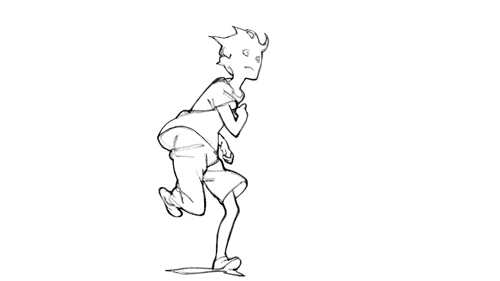

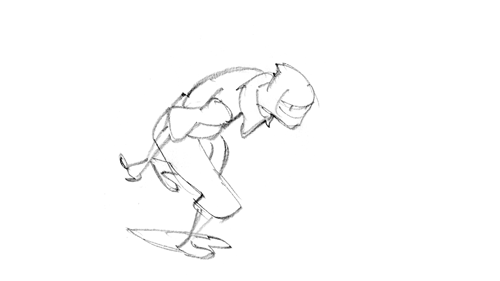

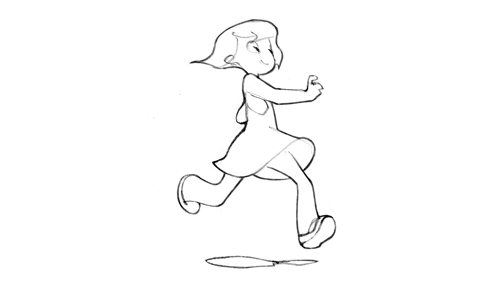



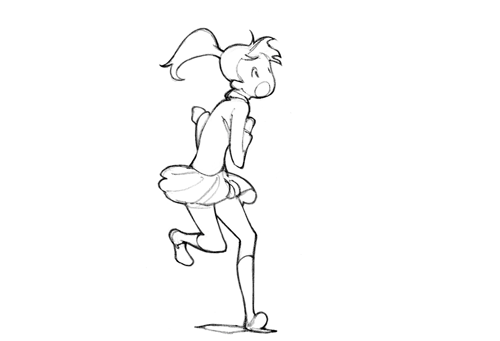
Some animated running by Yoh Yoshinari (吉成曜)
Great tutorial by the director of Little Witch Academia, and key animator in: Gurren Lagann, FLCL, KILL la KILL, Evangelion, Panty & Stocking (X)
Amazing!!!
Models & Prototypes
 [Image: "Dome-shaped Architectural Staircase Model," courtesy of the Cooper Hewitt].
[Image: "Dome-shaped Architectural Staircase Model," courtesy of the Cooper Hewitt].If you liked those two staircase posts from earlier today, a reader has pointed out that the Cooper Hewitt has a whole slew of "Models & Prototypes" on display that seem worth checking out.
More specifically, it's "a gallery devoted to exhibiting three-dimensional representations of ideas that demonstrate the design process; test concepts and resolve problems; enhance presentations; and display complex technical skills."
Take a look at the "Dome-shaped Architectural Staircase Model" from the mid-19th-century, for example, seen above, or this gorgeous "staircase model from France".
 [Image: A "staircase model from France," courtesy of the Cooper Hewitt].
[Image: A "staircase model from France," courtesy of the Cooper Hewitt].Freestanding and divorced from their ultimate architectural context, they become more like vertebrae or genetic helices spiraling in midair.
 [Image: "Staircase Model, France," courtesy of the Cooper Hewitt].
[Image: "Staircase Model, France," courtesy of the Cooper Hewitt].See more over at the Cooper Hewitt.
(Thanks to John O'Shea for the tip!)
Formation flight Sunday. Lightning IIs

Formation flight Sunday. Lightning IIs
Gyroscopolis
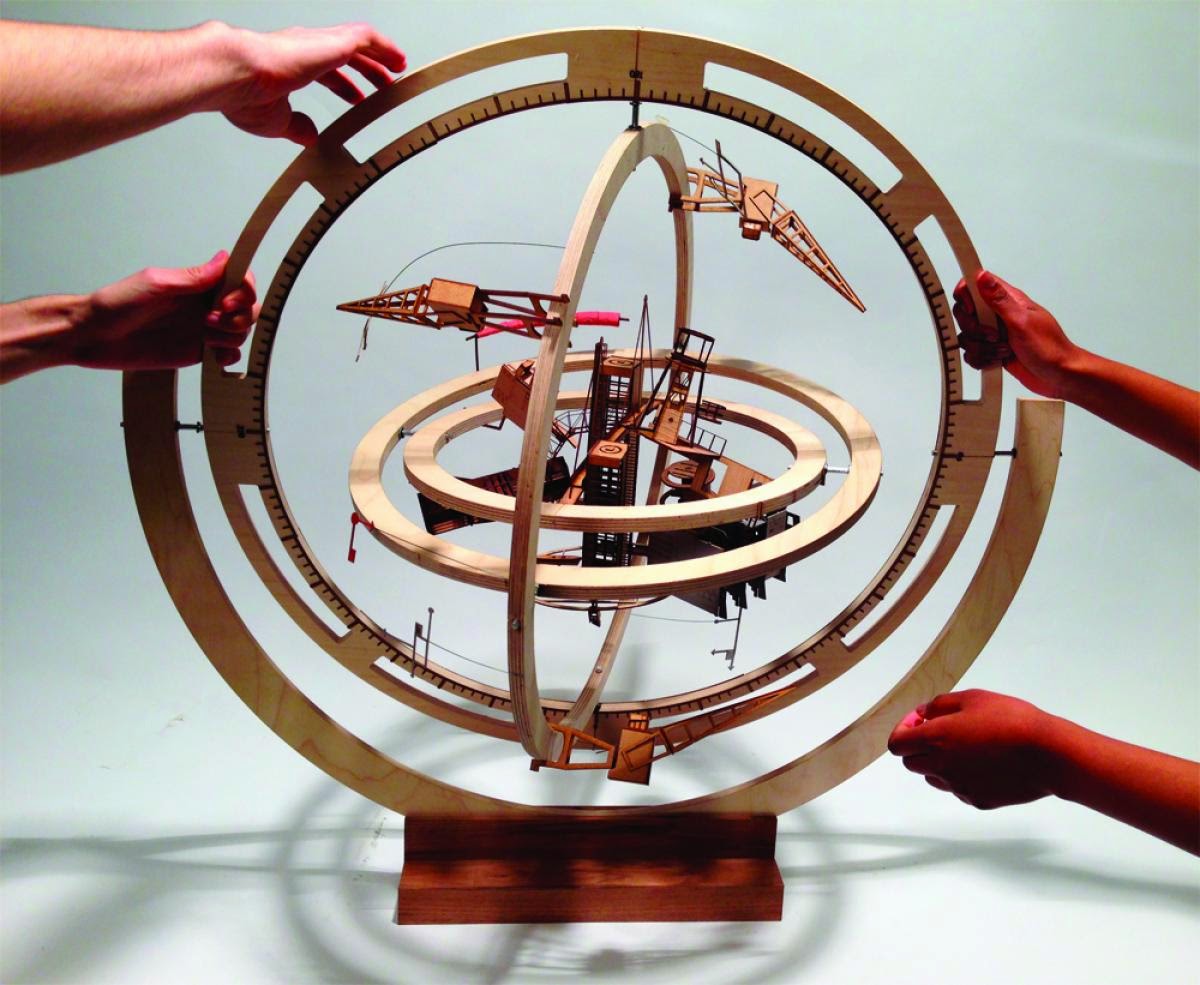 [Image: From "Destination Docklands" by Emma Colthurst; via Lobby].
[Image: From "Destination Docklands" by Emma Colthurst; via Lobby].This is such a clever architectural model: a project by Emma Colthurst from the Bartlett School of Architecture in London is presented as a narrative gyroscope, an urban universe of wheels within wheels, of shifting ground planes and emerging landscapes amidst a carousel of new horizons.
 [Image: From "Destination Docklands" by Emma Colthurst].
[Image: From "Destination Docklands" by Emma Colthurst].Called "Destination Docklands," it is intended as a kind of horological device, telling the story of the site through time.
This includes the "submerged industrial landscape" that re-arises with a turning of the gears to the towering cranes of as-yet unrealized construction projects set to transform the Docklands for generations.
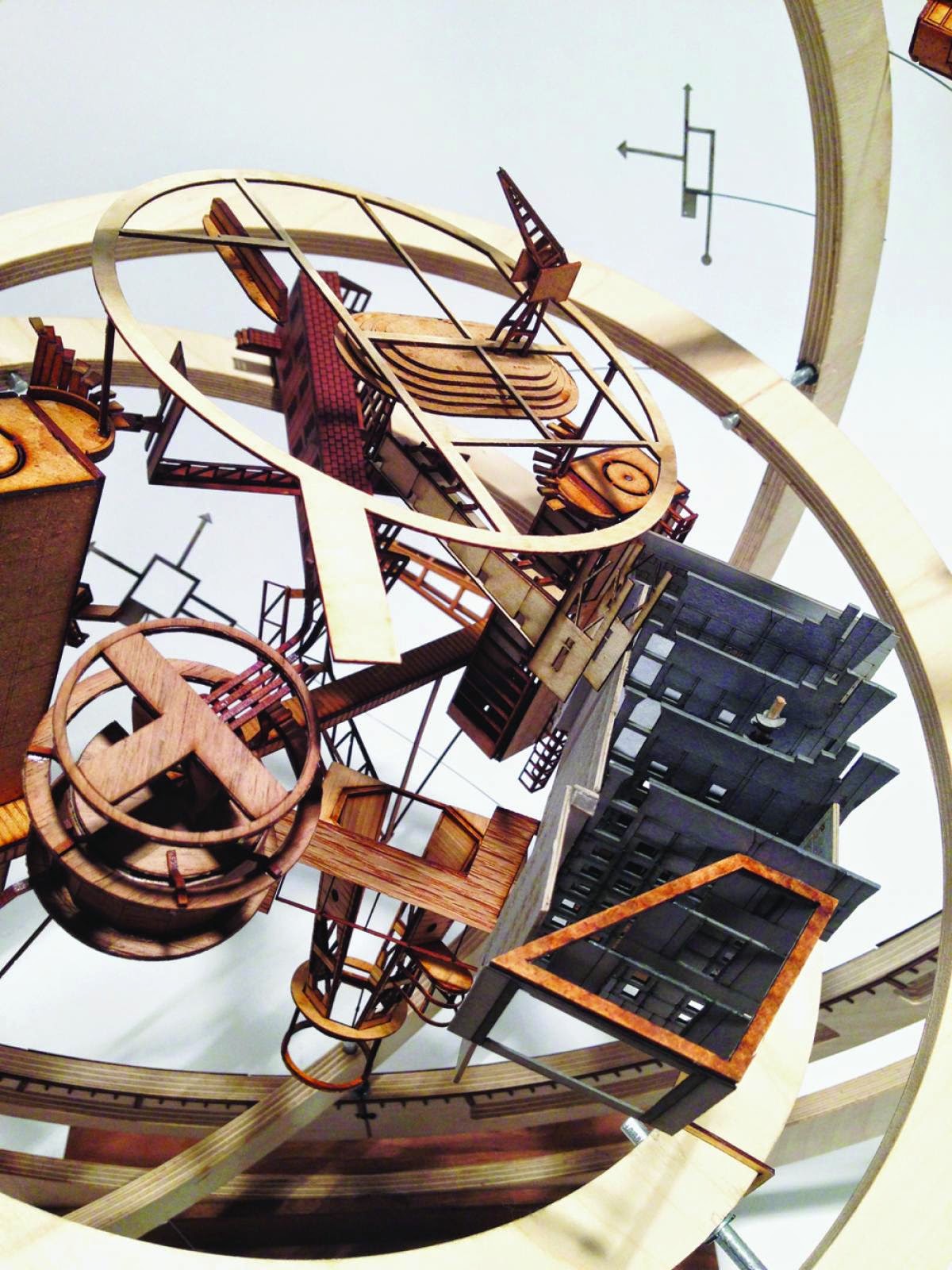 [Image: From "Destination Docklands" by Emma Colthurst].
[Image: From "Destination Docklands" by Emma Colthurst].As Colthurst herself explains over at Lobby:
"Destination Docklands" seeks to reconnect the remnant memory of the submerged industrial landscape. A Gimbal—a mechanism, typically consisting of rings pivoted at right angles, for keeping an instrument such as a compass or chronometer horizontal in a moving vessel or aircraft—holds the Dock’s spatiality in fragmented balance. Previously a device used for ship navigation, the Gimbal realigns glimpses of the area’s connected history, and its axes pivot perpendicularly, bringing their own relationship and meaning to the Dock. The Gimbal becomes a capsule for the connected "players" of this industrial world."As the rings turn," she adds, "the spatial relationships between the industrial worlds are juxtaposed against each other. As these tangible connections teeter on the edge of the Dock’s hemisphere, their world is refocused in moments of realisation, before falling away."
 [Image: From "Destination Docklands" by Emma Colthurst].
[Image: From "Destination Docklands" by Emma Colthurst].The result is a gyroscopic scenography of different contexts rolling into view, momentarily aligning, and then sinking once again into the urban murk of potential rearrangements yet to come.
Read more about the project over at the recently launched Lobby.
9 Squares: A Collaborative GIF Project for Nine Designers Using Four Colors in Three Seconds

Top: David Stanfield, Al Boardman, Brent Clouse; Middle: Skip Hursh, Erica Gorochow, John Flores; Bottom: Austin Saylor, Adam Plouff, Bran Dougherty-Johnson

Top: David Stanfield, Allen Laseter, Jimmy Simpson; Middle: Skip Hursh, Al Boardman, Jeff Briant; Bottom: Marcus Chaloner, Erik Blad, Fede Cook

Top: Sara Bennett, Bran Dougherty-Johnson, Brandon Wall; Middle: Zac Dixon, Oliver Sin, David Stanfield; Bottom: Al Boardman, Skip Hursh, Jeroen Krielaars

Top: Skip Hursh, Damien Correll, Cindy Suen; Middle: Justin Cassano, David Stanfield, Joshua Hollars; Bottom: Al Boardman, Jorge R. Canedo Estrada, Estelle Caswell
9 Squares is a collaborative motion graphics project where 9 designers are given a 350-pixel square, four colors, and three seconds to create any kind of animation they like. The results are gathered together to create a single GIF. 9 Squares is organized by Skip Dolphin Hursh, David Stanfield, and Al Boardman and they hope to post a new collaboration every two week or so. (via Quipsologies)
A Woolen Ape Explores a Backyard Garden in a New Short from Marc & Emma
As part of a promotional campaign for Wonderlijk Wild (Miraculously Wild), an effort to encourage home gardening in Belgium, filmmaking duo Emma De Swaef and Marc James Roels of Marc & Emma were hired to create this wonderful short about a felted green ape exploring the outdoors. You might remember their work from this other woolen animation featuring two doughy wrestlers for the National Animation Festival last year. (via Vimeo)



Update: An earlier version of this post referred to the film as “stop-motion” when in fact it’s actually live-action puppeteering.
Not Seeing The World
This photo series by fellow Swiss Clarina Bezzola is hitting a cord with me. It’s titled Not seeing the World and depicts an individual who is constantly absorbed in the dialogues with her inner voices and misses the beautiful world around.
Infrastructure as Processional Space
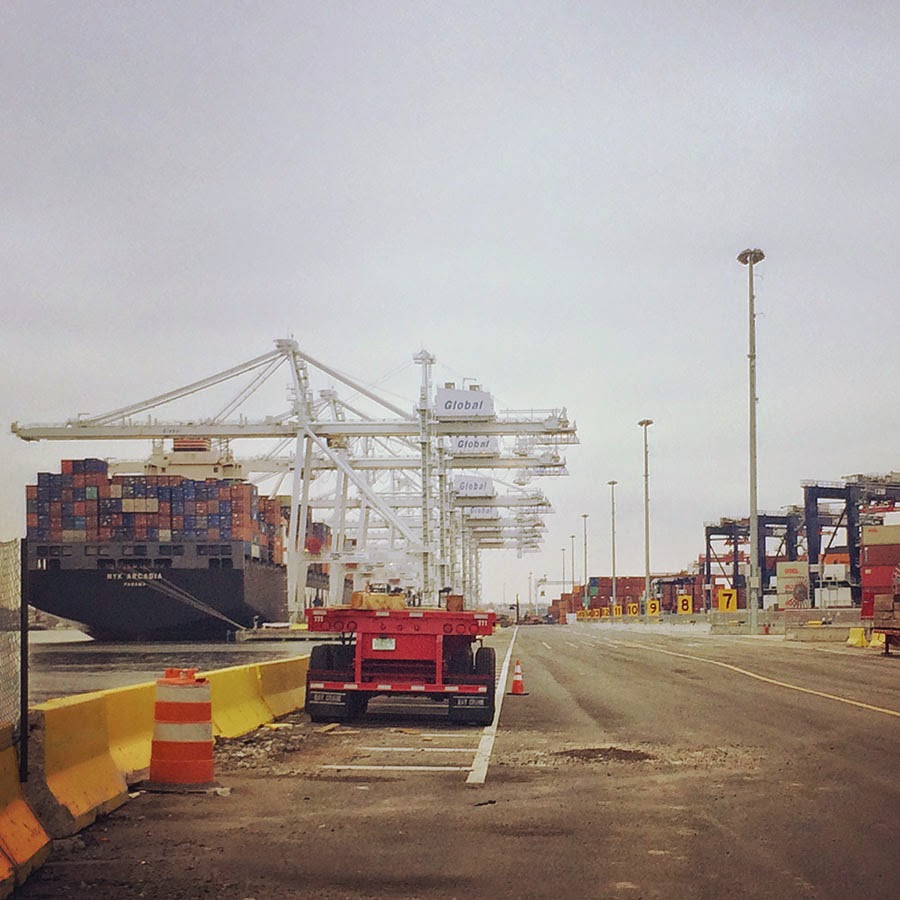 [Image: A view of the Global Containers Terminal in Bayonne; Instagram by BLDGBLOG].
[Image: A view of the Global Containers Terminal in Bayonne; Instagram by BLDGBLOG].I just spent the bulk of the day out on a tour of the Global Containers Terminal in Bayonne, New Jersey, courtesy of the New York Infrastructure Observatory.
That's a new branch of the institution previously known as the Bay Area Infrastructure Observatory, who hosted the MacroCity event out in San Francisco last May. They're now leading occasional tours around NYC infrastructure (a link at the bottom of this post lets you join their mailing list).
 [Image: A crane so large my iPhone basically couldn't take a picture of it; Instagram by BLDGBLOG].
[Image: A crane so large my iPhone basically couldn't take a picture of it; Instagram by BLDGBLOG].There were a little more than two dozen of us, a mix of grad students, writers, and people whose work in some way connected them to logistics, software, or product development—which, unsurprisingly, meant that everyone had only a few degrees of separation from the otherworldly automation on display there on the peninsula, this open-air theater of mobile cranes and mounted gantries whirring away in the precise loading and unloading of international container ships.
The clothes we were wearing, the cameras we were using to photograph the place, even the pens and paper many of us were using to take notes, all had probably entered the United States through this very terminal, a kind of return of the repressed as we brought those orphaned goods back to their place of disembarkation.
 [Images: The bottom half of the same crane; Instagram by BLDGBLOG].
[Images: The bottom half of the same crane; Instagram by BLDGBLOG].Along the way, we got to watch a room full of human controllers load, unload, and stack containers, with the interesting caveat that they—that is, humans—are only required when a crane comes within ten feet of an actual container. Beyond ten feet, automation sorts it out.
When the man I happened to be watching reached the critical point where his container effectively went on auto-pilot, not only did his monitor literally go blank, making it clear that he had seen enough and that the machines had now taken over, but he referred to this strong-armed virtual helper as "Auto Schwarzenegger."
"Auto Schwarzenegger's got it now," he muttered, and the box then disappeared from the screen, making its invisible way to its proper location.
 [Image: Waiting for the invisible hand of Auto Schwarzenegger; Instagram by BLDGBLOG].
[Image: Waiting for the invisible hand of Auto Schwarzenegger; Instagram by BLDGBLOG].Awesomely—in fact, almost unbelievably—when we entered the room, with this 90% automated landscape buzzing around us outside on hundreds of acres of mobile cargo in the wintry weather, they were listening to "Space Oddity" by David Bowie.
"Ground control to Major Tom..." the radio sang, as they toggled joysticks and waited for their monitors to light up with another container.
 [Image: Out in the acreage; Instagram by BLDGBLOG].
[Image: Out in the acreage; Instagram by BLDGBLOG].The infinitely rearrangeable labyrinth of boxes outside was by no means easy to drive through, and we actually found ourselves temporarily walled in on the way out, just barely slipping between two containers that blocked off that part of the yard.
This was "Damage Land," our guide from the port called it, referring to the place where all damaged containers came to be stored (and eventually sold).
 [Image: One of thousands of stacked walls in the infinite labyrinth of the Global Containers Terminal; Instagram by BLDGBLOG].
[Image: One of thousands of stacked walls in the infinite labyrinth of the Global Containers Terminal; Instagram by BLDGBLOG].One of the most consistently interesting aspects of the visit was learning what was and was not automated, including where human beings were required to stand during some of the processes.
For example, at one of several loading/unloading stops, the human driver of each truck was required to get out of the vehicle and stand on a pressure-sensitive pad in the ground. If nothing corresponding to the driver's weight was felt by sensors on the pad, the otherwise fully automated machines toiling above would not snap into action.
This idea—that a human being standing on a pressure-sensitive pad could activate a sequence of semi-autonomous machines and processes in the landscape around them—surely has all sorts of weird implications for everything from future art or museum installations to something far darker, including the fully automated prison yards of tomorrow.
 [Image: One of several semi-automated gate stations around the terminal; Instagram by BLDGBLOG].
[Image: One of several semi-automated gate stations around the terminal; Instagram by BLDGBLOG].This precise control of human circulation was also built into the landscape—or perhaps coded into the landscape—through the use of optical character recognition software (OCR) and radio-frequency ID chips. Tag-reading stations were located at various points throughout the yard, sending drivers either merrily on their exactly scripted way to a particular loading/unloading dock or sometimes actually barring that driver from entry. Indeed, bad behavior was punished, it was explained, by blocking a driver from the facility altogether for a certain amount of time, locking them out in a kind of reverse-quarantine.
Again, the implications here for other types of landscapes were both fascinating and somewhat ominous; but, more interestingly, as the trucks all dutifully lined-up to pass through the so-called "OCR building" on the far edge of the property, I was struck by how much it felt like watching a ceremonial gate at the outer edge of some partially sentient Forbidden City built specifically for machines.
In other words, we often read about the ceremonial use of urban space in an art historical or urban planning context, whether that means Renaissance depictions of religious processions or it means the ritualized passage of courtiers through imperial capitals in the far east. However, the processional cities of tomorrow are being built right now, and they're not for humans—they're both run and populated by algorithmic traffic control systems and self-operating machine constellations, in a thoroughly secular kind of ritual space driven by automated protocols more than by democratic legislation.
These—ports and warehouses, not churches and squares—are the processional spaces of tomorrow.
 [Image: Procession of the True Cross (1496) by Gentile Bellini, via Wikimedia].
[Image: Procession of the True Cross (1496) by Gentile Bellini, via Wikimedia].It's also worth noting that these spaces are trickling into our everyday landscape from the periphery—which is exactly where we are now most likely to find them, simply referred to or even dismissed as mere infrastructure. However, this overly simple word masks the often startlingly unfamiliar forms of spatial and temporal organization on display. This actually seems so much to be the case that infrastructural tourism (such as today's trip to Bayonne) is now emerging as a way for people to demystify and understand this peripheral realm of inhuman sequences and machines.
In any case, as the day progressed we learned a tiny bit about the "Terminal Operating System"—the actual software that keeps the whole place humming—and it was then pointed out, rather astonishingly, that the actual owner of this facility is the Ontario Teachers' Pension Plan, an almost Thomas Pynchonian level of financial weirdness that added a whole new level of narrative intricacy to the day.
If this piques your interest in the Infrastructure Observatory, consider following them on Twitter: @InfraObserve and @NYInfraObserve. And to join the NY branch's mailing list, try this link, which should also let you read their past newsletters.
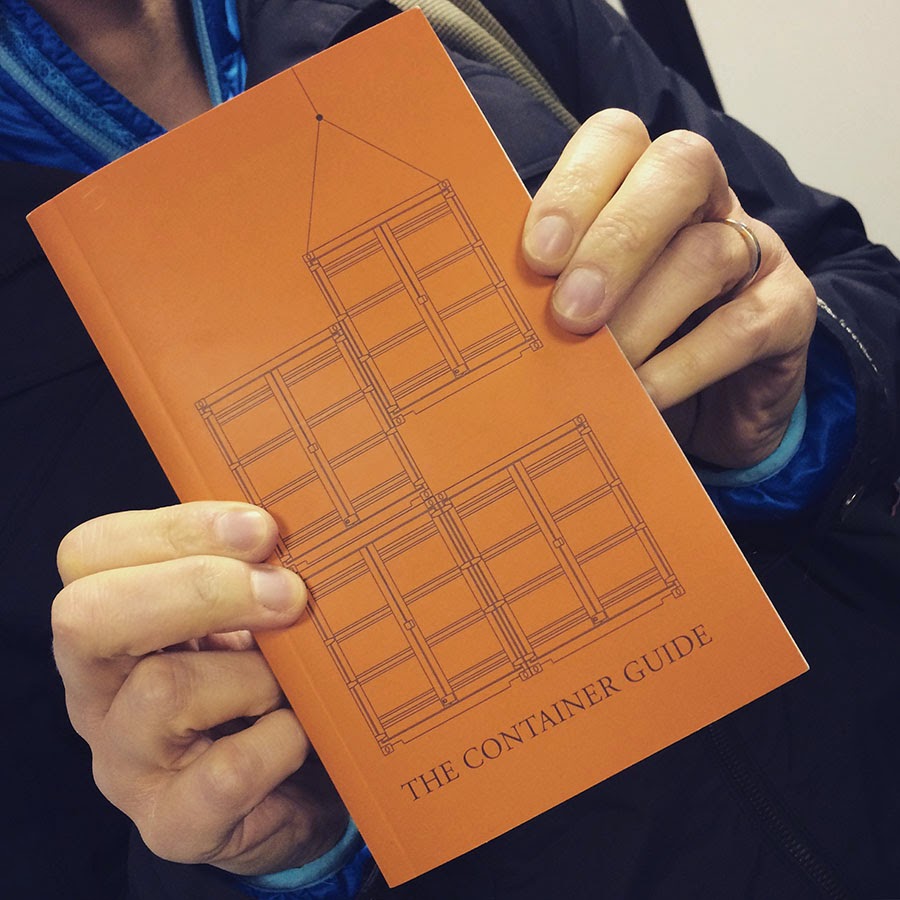 [Image: The Container Guide; Instagram by BLDGBLOG].
[Image: The Container Guide; Instagram by BLDGBLOG].Finally, the Infrastructure Observatory's first publication is also now out, and we got to see the very first copy. The Container Guide by Tim Hwang and Craig Cannon should be available for purchase soon through their website; check back there for details (and read a bit more about the guide over at Edible Geography).
(Thanks to Spencer Wright for the driving and details, and to the Global Containers Terminal Bayonne for their time and hospitality!)







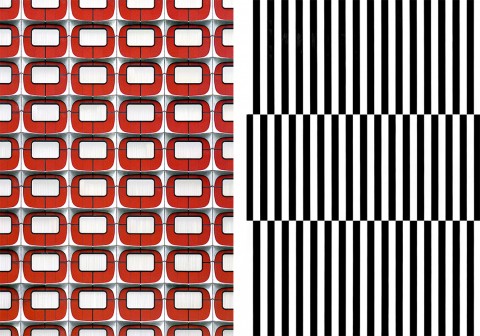
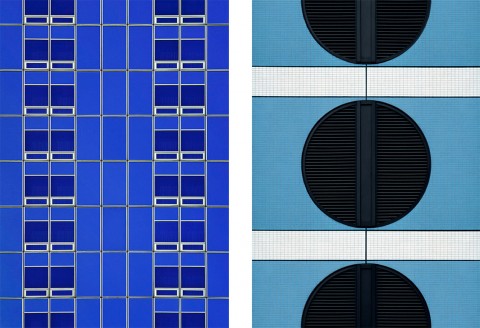
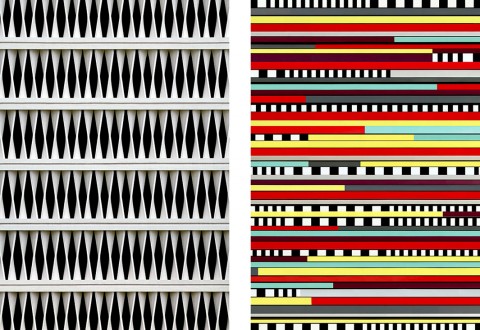
 (
(

